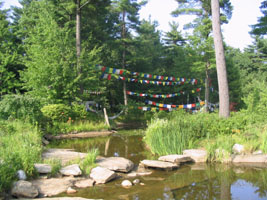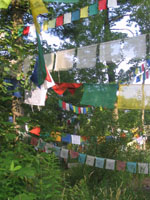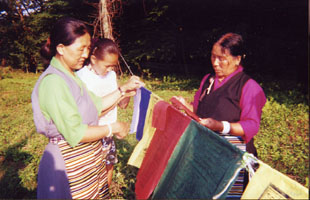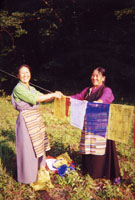Lori A. Snyder
Social Studies Department
Longmeadow High School
Home
Tibetan Prayer Flags
|
An important element of lay Buddhist practice is pilgrimage to holy sites. In Tibetan Buddhism, laity will prostrate themselves, turn prayer wheels and hang prayer flags.
|
 |
 |
Sometimes, practitioners will hang prayer flags at an auspicious location to gain merit for themselves, their family, to honor a holy person or patron deity, as well as for the benefit of all sentient beings.
|
|
Five-colored prayer flags will have Buddhist prayers and mantras written on them that convey ideals such as compassion, wisdom, peace and good fortune.
|
 |
 |
As
the flags flutter in the wind, Tibetans believe that the sacred
windhorse, often pictured in the center of prayer flags, carries
off the prayers of good wishes to benefit others.
|
|
They
will be flown in high places around monasteries, shrines, off roof
tops and along mountain passes, where they are hung by travelers
as offerings for safe passage.
|
 |
 |
Traditionally,
prayer flags are printed on square or rectangular swatches of cloth
in a variety of sizes. After they are printed, they are hung with
string in sets of five colors, each corresponding to the natural
elements, from left to right: Blue (sky), White (clouds), Red (fire),
Green (water) Yellow (earth).
|
|
Student Activity: Making Tibetan Prayer Flags An excellent resource for making Tibetan Prayer Flags may be found in the curriculum binder, Presenting Tibet, published by Global Source Network. The same teaching curriculum binder may be borrowed from The Teacher's Center for Global Studies, Clark University, Worcester, MA. Contact Mimi Stephens. To purchase prayer flags for classroom use, you may wish to support the local Tibetan store, A Glimpse of Tibet located in Thorne's Marketplace in Northampton, MA. For more on Tibetan Buddhism
|
 |
This site was created by Lori A. Snyder at the NEH Summer Institute "Cultures and Religions of the Himalayan Region," held at the College of the Holy Cross, Summer 2004